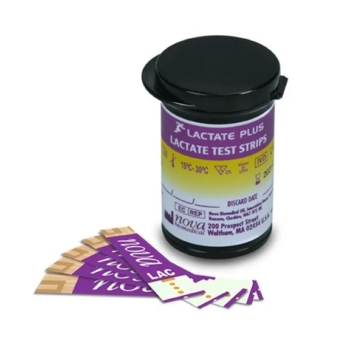Knowledge Hub
What to Consider When Investing in a Blood Lactate Meter
Blood lactate meters are essential pieces of medical and athletic equipment. Used across both medical diagnosis and monitoring and athletic training programmes, it is crucial that the equipment being used to test blood lactate levels can be relied upon for repeated use and accurate results.
Choosing the right blood lactate meter for your application ensures your testing kit supports your goals.
In this article, we discuss the main blood lactate meter considerations you will need to be aware of when choosing a testing kit, ensuring you make an informed decision when it comes to selecting the right equipment for you. We also discuss how to get the most out of your blood lactate monitor in order to maximise its performance.
Factors to Consider When Choosing a Blood Lactate Meter
When choosing a blood lactate meter, there are several factors that could influence your decision. Some of the main blood lactate meter considerations include the accuracy of the meter, the sample size required, cost, portability, memory capacity and altitude limit.
Accuracy and Precision
Precision and accuracy are crucial when using blood lactate meters to ensure reliable measurements. These meters are designed to measure the concentration of lactate in the blood, which can be used as an indicator of a medical patient’s health and an athlete's performance level.
Factors such as the quality of the sensor, the calibration process, and the manufacturing standards can all affect the accuracy and precision of the meter.
Choosing meters at the forefront of the market for their accuracy will ensure you can rely on the results of tests. The accuracy of your meter can further be validated with control solutions throughout the life of the meter.
Sample Size Required
Different test kits require different blood sample sizes. Meters which require a smaller sample size per reading will lead to increased comfort for the patient, since less blood is required, we can use a smaller lancet which creates a smaller wound that heals faster and is not sore to touch.
Testing Speed
Faster testing speed allows for quicker data collection and analysis, with results being typically provided within seconds.
This enables you to make immediate decisions based on real-time data. This not only enhances performance monitoring but also facilitates timely interventions and adjustments to training or treatment plans.
Cost and Affordability
Cost plays a significant role in determining which meter is the best fit for your needs.
The price of blood lactate meters vary, so it's essential to compare different options. While some meters have a higher upfront cost, they may offer additional features or higher accuracy. On the other hand, there are more budget-friendly options available that still provide reliable readings.
When examining cost, it’s important to factor in not only the meter but auxiliary equipment within the kit, especially the single-use equipment that will need replacing regularly. When committing to a budget, consider these ongoing costs as part of the expense.
Size and Portability
Another factor to consider is the compactness and ease of carrying around the meter. This is especially important for fitness applications, where blood lactate meters may be carried to different venues and packed away in medical bags.
Memory Capacity
A key feature to consider is the meter's memory capacity, allowing you to easily track and analyse data over time. With a larger memory capacity, you can store more measurements and have a comprehensive record of lactate levels during different training sessions or across medical records.
This enables you to identify patterns, monitor progress, and make informed decisions. Additionally, a blood lactate meter with a high memory capacity allows you to compare data from different time periods and evaluate the effectiveness of any changes you've made to your training routine or health regime.
Altitude Limit
For athletes, it’s important to know the altitude limit at which your meter can accurately measure and analyse your lactate in order to fully optimise your training sessions.
Most top-of-the-range blood lactate meters have a recommended altitude limit of around 4,000 meters.
It's crucial to be aware of this limitation, especially if you train or compete at high altitudes in order to maintain the accuracy of your readings.
What Equipment Do I Need to Use a Blood Lactate Meter?
Your blood lactate meter kit should be complete with blood testing strips, control solution, and lancets to ensure that you can complete the test. This equipment may be purchased individually or as a blood lactate monitor bundle. You will also need access to a sharps bin and disposable gloves in order to test safely.
Blood Lactate Testing Strips
Blood lactate test strips are an essential component of a blood lactate testing kit. They're designed to analyse the amount of lactate present in your blood sample.
Blood pricked from the finger or earlobe is placed on the strip, which is inserted into the meter. The strips can also be used for control tests.
Blood testing strips are single-use, and must be disposed of after they have been soiled, meaning having a supply of test strips ready for use is essential.
Lactate Control Solution
Lactate control solutions should be used at regular intervals and especially when equipment has been compromised to ensure your meter and test kit are working accurately.
The control solution contains a known concentration of lactate, which allows you to compare the meter's reading with the expected value. This way, you can verify that your meter is functioning properly and producing reliable results. Different control solutions are available for testing both normal and high range verification.
Safety Lancets and Sharps Bin
Safety lancets are medical devices designed for the convenient and painless collection of blood samples.
Safety lancets work by a mechanism that quickly punctures the skin, creating a small, controlled incision. This minimizes discomfort and reduces the risk of infection by ensuring a sterile procedure. Once a small drop of blood is obtained, it can be easily applied to the blood lactate meter's test strip.
You should have access to a sharps bin when undertaking testing in order to safely dispose of used lancets, providing peace of mind and ensuring the safety of those coming into contact with the lancets.
Disposable Gloves
It is recommended that medical grade disposable gloves are worn by the tester when performing a blood lactate test. This prevents the spread of blood-borne viruses and ensures the safety of the tester and those being tested.
They are designed to be single-use and should be discarded after each patient interaction to prevent cross-contamination.
Getting the Best from Your Blood Lactate Monitor
To maximise the performance of your blood lactate meter, make sure to follow the instructions and guidelines provided by the manufacturer. This includes properly storing and handling the device to maintain its accuracy and longevity.
Additionally, we discuss cleaning and disinfecting your meter to ensure safe, reliable and accurate results.
Following Instructions and Guidelines
Your lactate meter should come with an instruction manual and guidelines for use, either contained within the packaging or available digitally. It’s important to adhere to these instructions to extend the longevity of the meter and ensure accurate results.
Make sure to carefully read and understand the user manual before using the device and consult the official guidelines if any problems should occur when using the device.
Ensuring Proper Storage and Handling of the Device
Proper storage and handling are essential to keeping your meter working efficiently and accurately. Firstly, the device should be stored in a clean and dry environment. You should also avoid exposing it to excessive heat or cold, as extreme temperatures can damage the device and affect its performance.
When not in use, store the device in its protective case to prevent any scratches or damage.
When handling the device during testing, the tester should wear clean, disposable gloves to ensure the device is kept sanitary.
Routinely Cleaning and Maintaining the Meter
Regular cleaning and a proper maintenance schedule are essential when handling blood lactate meters, because of their proximity to blood and other bodily fluids such as sweat. Cleaning and disinfecting the blood lactate meter after every use is crucial to prevent the build-up of contaminants and transmission of blood-borne pathogens between patients and healthcare professionals.
The external surface of the meter can be cleaned with a clean disinfectant wipe.
To disinfect the meter, a fresh disinfectant wipe should then be used, wiping the surface a minimum of three times horizontally and three times vertically. Make sure you avoid the test strip port during this practice.
The meter should then be left to air dry, ready for its next use.
Conclusion
Investing in the right blood lactate monitoring equipment is vital for the ongoing success of your testing practices. Whether you’re purchasing a blood lactate meter for use within the medical, fitness, or academic field, finding a meter and kit which suits your budget, goals, and usage is key to lasting compatibility.
And once you’ve found the right meter, handling it in line with official guidelines will help keep your equipment performing at optimum capacity, as well as keeping those using the equipment safe.
Speak to the experts
Got a question?






